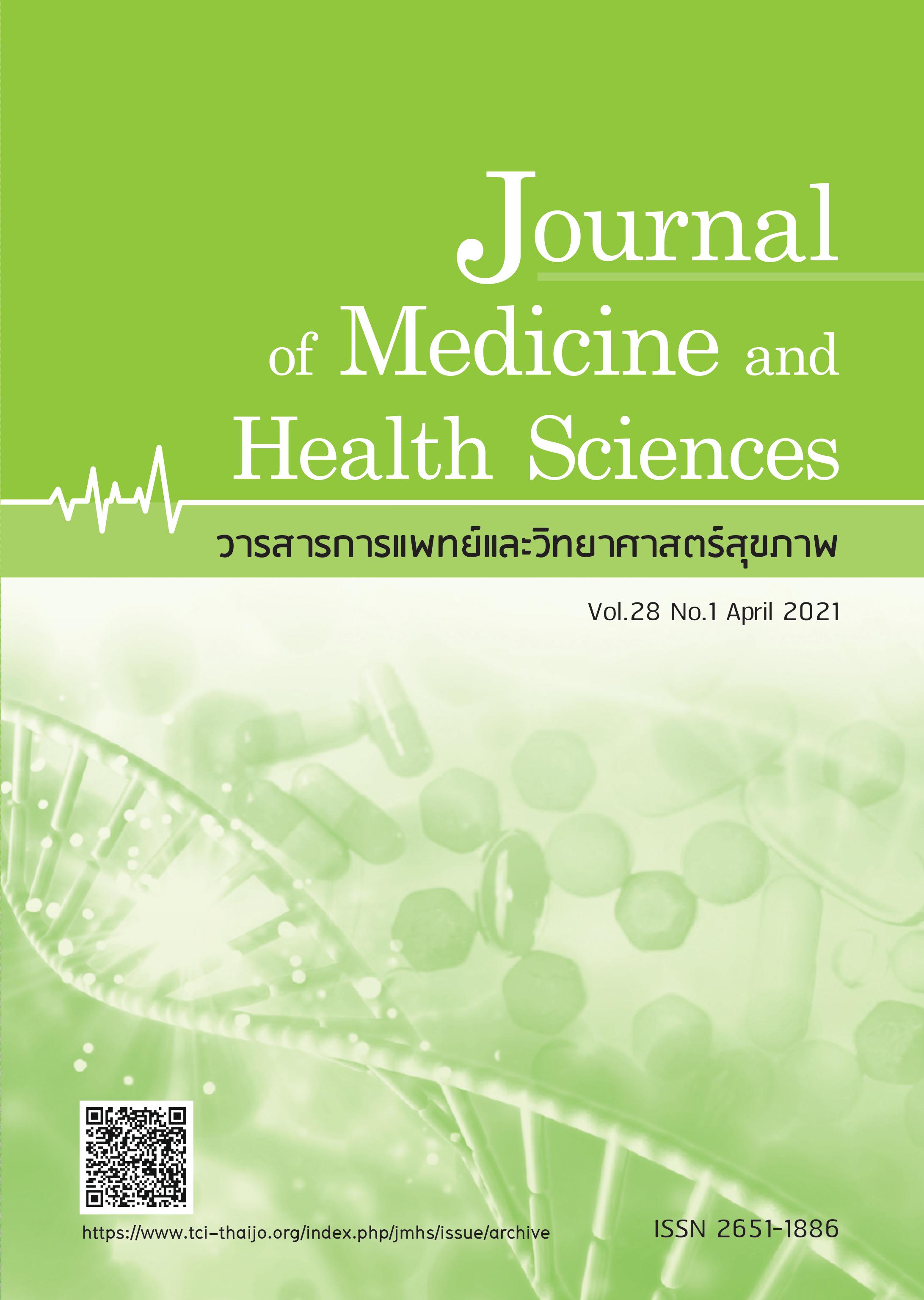Oral exfoliative cytology: Basic to clinical application
Keywords:
oral cavity, exfoliative cytology, squamous cell carcinoma, oral potentially malignant disordersAbstract
Oral and oropharyngeal cancer, grouped together, are the sixth most common cancer in the world. Oral squamous cell carcinoma (OSCC) accounts for more than 95% of all oral cancers. OSCCs diagnosed at a late stage often results in a diminished quality of life and impaired function. OSCC could be preceded by oral potentially malignant disorders (OPMDs), for example, leukoplakia and erythroplakia. Thus, an early diagnosis of OSCC and OPMD is an effective strategy to reduce mortality and morbidity rates and improve the quality of life of the patients. At present, oral exfoliative cytology is an effectively adjuvant diagnostic techniques, which is a minimally invasive method to collect cells from the suspected oral mucosa, a relatively simple and inexpensive technique, and provide high accuracy results in the diagnostic steps. However, in Thailand, using the oral exfoliative cytology technique has been limited. This review article describes historical development, basic techniques, diagnostic guidelines, efficacy, and the future direction of oral exfoliative cytology. The aim of this article is to clarify basic knowledge and the clinical application of oral exfoliative cytology to Thai health care personnel.
References
2. Tangjaturonrasme N, Vatanasapt P, Bychkov A. Epidemiology of head and neck cancer in Thailand. Asia-Pac J Clin Oncol 2018;14:16-22.
3. El-Naggar AK, Chan JKC, Grandis JR, et al, editors. WHO classification of head and neck tumours. 4th ed. Lyon: IARC; 2017.
4. Hospital-based cancer registry 2018 [internet]. Bangkok (Thailand): New Thammada press Co., Ltd.; 2018. The most common top 10 cancer of male and female; [cited 2020 Apr 6]; p. 2-4. Available from: http://www.nci.go.th/th/ File_download/Nci%20Cancer%20 Registry/Hospital%20Based_2018.pdf.
5. Imsamran W, Chaiwerawattana A, Wiangnon S, et al. Cancer in Thailand Vol. VIII, 2010-2012. Bangkok: New Thammada press Co., Ltd.; 2015.
6. Sangkaew P, Ittichaicharoen J, Iamaroon A, et al. Oral potentially malignant disorders: clinical manifestations and malignant transformation. CM Dent J 2019;
40:23-42. (In Thai)
7. Worasuttayangkurn W, Khovidhunkit SP, Rungsiyanont S. Comparative study on the effectiveness of Velscope and Toluidine blue for oral premalignant lesion screening. SWU Dent J 2018;11: 24-42. (In Thai)
8. Chitturi RT, Rathinam E, Santo R, et al. The role of exfoliative cytology and molecular biology in oral potentially malignant disorders. J Health Res Rev 2017;4:43-6.
9. Rungsiyanont S, Khovidhunkit SP, Talungchit S, et al. A comparative study of the effectiveness of clinical adjunctive techniques on the diagnosis of potentially
malignant disorders and oral cancers. SWU Dent J 2015;8:49-67. (In Thai)
10. Mehrotra R, Hullmann M, Smeets R, et al. Oral cytology revisited. J Oral Pathol Med 2009;38:161-6.
11. Mehrotra R. The role of cytology in oral lesions: a review of recent improvements. Diagn Cytopathol 2012;40:73-83.
12. Shingleton HM, Patrick RL, Johnston WW, et al. The current status of the Papanicolaou smear. CA Cancer J Clin 1995;45:305-20.
13. Varma K, Hille J, Afrogheh A, et al. Oral cytology techniques In: Mehrotra R, editor. Oral cytology a concise guide. 1st ed. USA: Springer; 2013. p. 11-26.
14. Roongpuvapaht B, Bhongmakapat T, Pongtippan A. Sensitivity and specificity of liquid-based preparation brush cytology in cancer of oral cavity and oropharynx [master’s thesis]. [Bangkok]: Mahidol University; 2009.
15. Jantabenjapat J. Accuracy of fine needle aspiration cytology in diagnosis of salivary gland mass. Region 4-5 Medical Journal 2017;36:277-90.
16. Papanicolaou GN, Traut HF. Diagnosis of uterine cancer by the vaginal smear. Yale J Biol Med 1943;15:924.
17. Papanicolaou GN. A survey of the actualities and potentialities of exfoliative cytology in cancer diagnosis. Ann Intern Med 1949;31:661-74.
18. Montgomery PW, Haam von E. A study of the exfoliative cytology in patients with carcinoma of the oral mucosa. J Dent Res 1951;30:308-13.
19. Cawson RA. The cytological diagnosis of oral cancer. Br Dent J 1960;19:294-8.
20. King OH. Intraoral exfoliative cytology technics. Acta Cytol 1963;7:327-9.
21. Salley JJ. Experimental carcinogenesis in the cheek pouch of the Syrian hamster. J Dent Res 1954;33:253-62.
22. Stahl SS. Exfoliative cytology in an experimentally induced carcinoma of the hamster cheek pouch. Acta Cytol 1963;7:262-7.
23. Staats OJ, Goldsby JW. Graphic comparison of intraoral exfoliative cytology technics.Acta Cytol 1963;7:107-10.
24. Sandler HC. The cytologic diagnosis of tumors of the oral cavity. Acta Cytol 1964;8:114-20.
25. Murata PJ, Johnson RA, McNicoll KE. Controlled evaluation of implementing the cytobrush technique to improve Papanicolaou smear quality. Obstet Gynecol 1990;75:690-5.
26. Boon ME, Alons-van Kordelaar JJ, RietveldScheffers PE. Consequences of the introduction of combined spatula and cytobrush sampling for cervical cytologyimprovements in smear quality and detection rates. Acta Cytol 1986;30:264-70.
27. Ogden GR, Cowpe JG, Green M. Cytobrush and wooden spatula for oral exfoliative cytology. A comparison. Acta Cytol 1992;36:706-10.
28. Jone AC, Pink FE, Sandow PL, et al. The cytobrush plus cell collector in oral cytology. Oral Surg Oral Med Oral Pathol 1994;77:95-9.
29. Sciubba JJ. Improving detection of precancerous and cancerous oral lesions. Computer-assisted analysis of the oral brush biopsy. US Collaborative OralCDx Study Group. J Am Dent Assoc 1999;130:1445-57.
30. Scheifele C, Schmidt-Westhausen AM, Dietrich T, et al. The sensitivity and specificity of the OralCDx technique. Oral Oncol 2004;40:824-8.
31. Hayama FH, Motta ACF, de Padua AGS, et al. Liquid-based preparations versus conventional cytology: specimen adequacy and diagnosis agreement in oral lesions. Med Oral Patol Oral Cir Bucal 2005;10:115-22.
32. Navone R, Burlo P, Pich A, et al. The impact of liquid-based oral cytology on diagnosis of oral squamous dysplasia and carcinoma. Cytopathology 2007;18:356-60.
33. Maksem JA, Finnemore M, Belsheim BL, et al. Manual method for liquid-based cytology: A demonstration using 1,000 gynecological cytologies collected directly to vial and prepared by a smear-slide technique. Diagn Cytopathol 2001;25: 334-8.
34. Shukla S, Einstein A, Shukla A, et al. Comparison of specimen adequacy and smear quality in oral smears prepared by manual liquid-based cytology and conventional methods. J Oral Maxillofac Pathol 2015;19:315-8.
35. Berkan TK, Reeder JE, Lopez PA Jr, et al. A protocol for Papanicolaou staining of cytologic specimens following flow analysis. Cytometry 1986;7:101-3.



